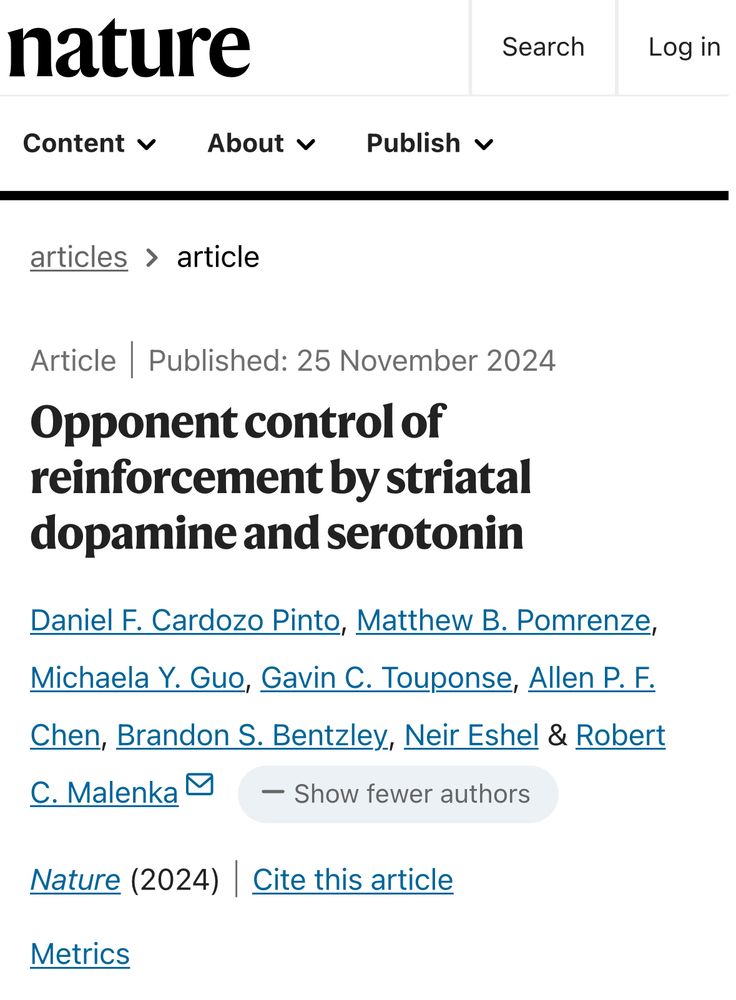Harvard Junior Fellow
Stanford PhD '23, Malenka lab
UC Berkeley BA '17, Lammel lab
https://scholar.google.com/citations?user=6E41N3AAAAAJ&hl=en
I'm at #sfn25 presenting new work that uncovers a key circuit mechanism underlying this opponency. Stop by poster AA3 Monday morning to learn more!


I'm at #sfn25 presenting new work that uncovers a key circuit mechanism underlying this opponency. Stop by poster AA3 Monday morning to learn more!
Our work also provides a characterization of the mesolimbic serotonin system that we hope will be resource for the field.
7/n

Our work also provides a characterization of the mesolimbic serotonin system that we hope will be resource for the field.
7/n
‼️ Enhancing dopamine activity preferentially activated D1-MSNs while enhancing serotonin activated D2-MSNs
6/n


‼️ Enhancing dopamine activity preferentially activated D1-MSNs while enhancing serotonin activated D2-MSNs
6/n
⬆️⬇️ Dopamine selectively excited D1-MSNs while serotonin selectively activated D2-MSNs
5/n

⬆️⬇️ Dopamine selectively excited D1-MSNs while serotonin selectively activated D2-MSNs
5/n
📊 expression varied across subregions and cell-types for every gene examined
❗️ Overall though, D1-MSNs expressed a mix of Gi, Gs, and Gq coupled serotonin receptors while D2-MSNs were enriched for receptors in the Gq coupled 5HT2 family
4/n

📊 expression varied across subregions and cell-types for every gene examined
❗️ Overall though, D1-MSNs expressed a mix of Gi, Gs, and Gq coupled serotonin receptors while D2-MSNs were enriched for receptors in the Gq coupled 5HT2 family
4/n
🎯 Mining a scRNA-Seq dataset revealed that >90% of MSNs express serotonin receptors, and that this is primarily limited to a subset of ~8 receptor genes
3/n

🎯 Mining a scRNA-Seq dataset revealed that >90% of MSNs express serotonin receptors, and that this is primarily limited to a subset of ~8 receptor genes
3/n
This inspired us to ask:
❓How does serotonin affect striatal neuron activity?
2/n

This inspired us to ask:
❓How does serotonin affect striatal neuron activity?
2/n
✅ inverse reward responses
✅ dopamine stimulation + serotonin inhibition was more reinforcing than dopamine stim alone‼️
8/n

✅ inverse reward responses
✅ dopamine stimulation + serotonin inhibition was more reinforcing than dopamine stim alone‼️
8/n
🐭 That's exactly what we found across multiple assays for contextual, Pavlovian, & instrumental learning
7/n

🐭 That's exactly what we found across multiple assays for contextual, Pavlovian, & instrumental learning
7/n
🤯 mice that lost both reward responses totally failed to learn a cue-reward association, bc they perceived the reward to be less reinforcing
6/n


🤯 mice that lost both reward responses totally failed to learn a cue-reward association, bc they perceived the reward to be less reinforcing
6/n
❗️When mice consumed a reward, dopamine ⬆️ serotonin ⬇️
5/n

❗️When mice consumed a reward, dopamine ⬆️ serotonin ⬇️
5/n
🔥 We identified a subregion of the striatum (NAc posterior medial shell) as a hotspot for converging dopamine & serotonin inputs
4/n

🔥 We identified a subregion of the striatum (NAc posterior medial shell) as a hotspot for converging dopamine & serotonin inputs
4/n
In one example, we labeled dopamine & serotonin neurons in the same mouse brain w/ different fluorescent proteins
Dopamine 🔴
Serotonin 🟢
3/n

In one example, we labeled dopamine & serotonin neurons in the same mouse brain w/ different fluorescent proteins
Dopamine 🔴
Serotonin 🟢
3/n
"Opponent control of reinforcement by striatal dopamine and serotonin", @Nature
Here, we show that dopamine and serotonin signals form a gas-brake system for reward in the mammalian brain
THREAD ⬇️
1/n

"Opponent control of reinforcement by striatal dopamine and serotonin", @Nature
Here, we show that dopamine and serotonin signals form a gas-brake system for reward in the mammalian brain
THREAD ⬇️
1/n

